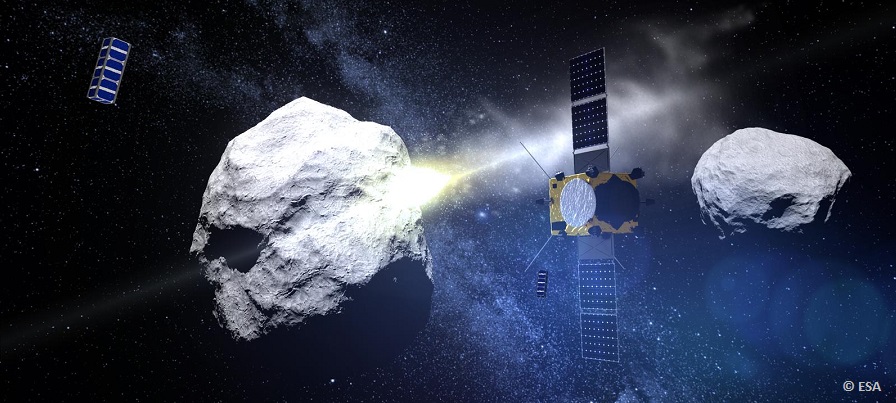A team led by Belgian researchers of the Observatory selected by ESA
A team led by Belgian researchers of the Royal Observatory of Belgium is selected by ESA to participate in an ESA/NASA mission study of asteroid deflection.
An international team led by the Royal Observatory of Belgium will study the scientific opportunities and technical challenges of using two triple-unit Cubesats onboard a proposed ESA mission – the Asteroid Impact Mission (AIM) to the binary asteroid 65803 Didymos. AIM is also set to be Europe’s contribution to a larger international endeavor called the Asteroid Impact & Deflection Assessment (AIDA) mission: NASA’s Double Asteroid Redirection Test (DART) will strike the smaller of the two Didymos asteroids, with AIM on hand for before-and-after monitoring of any resulting orbital and structural shifts.
Asteroid Geological Explorer (AGEX) is among the five proposals selected by ESA as a response to a call for ideas for the CubeSat Opportunity Payloads for the AIM mission. AGEX is led by the Royal Observatory of Belgium and includes participation of ISAE-SUPAERO (France), Antwerp Space (Belgium), Asteroid Initiatives LLC (USA) and EMXYS (Spain). AGEX aims to characterize the 65803 Didymos binary asteroid system by landing a CubeSat on its surface to assess the surface material, surface gravity, subsurface structure, and DART impact effects. Another CubeSat in orbit will deploy smaller ‘chipsats’ dispersed over the asteroid. AGEX will also study the changes in asteroid trajectory and rotation following the intentional impact of the DART spacecraft; paving the way for future technology that may one day be used to protect Earth from catastrophic asteroid impacts.
“The innovative experiments proposed by AGEX, will contribute to the scientific and asteroid mitigation objectives of the AIM mission, and demonstrate the feasibility of deep-space missions at a fraction of the cost of conventional, much larger spacecraft. However, operating two Cubesats in interplanetary space nearby an asteroid is very ambitious, with severe demands on system performance such as on-board autonomy, guidance navigation and control, communications, and propulsion.” says Özgür Karatekin of the Royal Observatory of Belgium, who leads the international team.
“Launched in October 2020, the AIM mission will approach Didymos in 2022, when it will be relatively close to Earth (at 11 million km). The binary asteroid Didymos consists of a main body with a diameter of 800 m, and its 170 m moon. AIM will be the first to test full-scale technologies needed to protect the Earth from a potentially catastrophic impact!” says Professor Véronique Dehant, the head of the Royal Observatory of Belgium’s Reference Systems and Planetology department where the study will take place.
The study will last eight months, after which ESA will select a final concept from five studies. The mission will be proposed to the Council of the European Space Agency in November 2016 for implementation.

